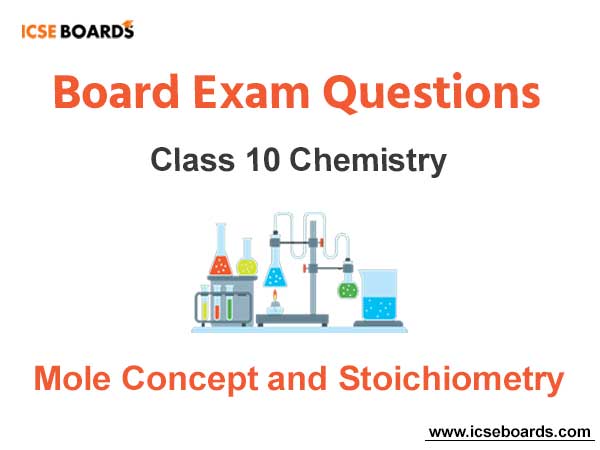Students of ICSE Class 10 should refer to Mole Concept and Stoichiometry ICSE Class 10 Chemistry board year questions and solutions. below which have come in past board exams. You should always go through questions that have come in previous years. This will help you to understand the pattern of questions in ICSE Class 10 Chemistry and prepare accordingly. This will help you to get better marks in ICSE Class 10 Board Exams
ICSE Class 10 Chemistry Mole Concept and Stoichiometry Board Exam Questions
Students should learn the important questions and answers given below for Chapter Mole Concept and Stoichiometry in Chemistry for ICSE Class 10. These board questions are expected to come in the upcoming exams. Students of ICSE Class 10th should go through the below board exams questions and answers which will help them to get more marks in exams.
Board Exam Questions Mole Concept and Stoichiometry ICSE Class 10 Chemistry
Question. An…………is the smaller unit of matter, which may or may not have an independent existence, but always takes part in a chemical reaction.
Answer
atom
Question. The relative molecular mass is a number that repesents how many times one……… of a substance is heavier than (1/12)th mass of carbon [126C].
Answer
molecule
Question. The temperature at which all molecular motion ceases is…………
Answer
absolute zero
Question. Whenever the gases react chemically, they do so in………… which bear a simple ratio to each other and to the products, if gaseous, provided the temperature and pressure of reacting gases and products remains the same.
Answer
volumes
Question. Equal volumes of all………under similar conditions of temperature and pressure, contain equal number of molecules.
Answer
gases
Question. The mass of substance containing particles equal to Avogadro’s number is called………
Answer
mole
Question. The number of atoms present in one molecule of a substance is its………
Answer
atomicity
Question. The ratio of certain mass of a gas or vapour to the mass of same volume of hydrogen is its……….
Answer
vapour density
Question. The volume occupied by one mole of a gas at S.T.P is………
Answer
gram molecular volume
Multiple Choice Questions
Question. The temperature at which all molecular motion ceases is :
(a) 0°C
(b) 100°C
(c) Zero power
(d) Absolute zero
Answer
D
Question. The volume occupied by 1 mole of gas at STP is :
(a) 2·24 litres
(b) 22·4 litres
(c) 2·42 litres
(d) 2·44 litres
Answer
B
Question. The volume occupied by 7 g of nitrogen at STP is :
(a) 5·4 litres
(b) 4·8 litres
(c) 5·6 litres
(d) 4·6 litres
Answer
C
Question. Which law states that “under the same conditions of temperature and pressure, equal volumes of all gases contain the same number of molecule.”
(a) Avogadro’s law
(b) Gay Lussac’s Law
(c) Mole Law
(d) Law of conservation of mass
Answer
A
Question. What is the value of Avogadro number ?
(a) 6·022 × 1023
(b) 6·022 × 10– 23
(c) 6·22 × 1023
(d) 6·22 × 10– 23
Answer
A
Question. One atomic mass unit is how much part the mass of carbon-12 atoms ?
(a) 1/4
(b) 1/12
(c) 1/8
(d) 1/16
Answer
B
Question. The number of atoms present in one molecule of an element is called its :
(a) Molecular number
(b) Atomic number
(c) Avogadro’s number
(d) Atomicity
Answer
D
Question. The vapour density of carbon dioxide [C = 12, O = 16] is :
(a) 12
(b) 16
(c) 44
(d) 22
Answer
D
Question. The empirical formula of hexane is :
(a) C2H7
(b) C5H8
(c) C3H7
(d) C4H7
Answer
C
Question. If empirical formula of an organic compound is CH2O then its molecular formula can be :
(a) C2H2O2
(b) C2H4O
(c) C3H6O
(d) C6H12O6
Answer
D
Give One Word/Chemical Term
Question. The law which states that—“under similar conditions of temperature and pressure the volume of gases taking part in a chemical reaction bear a simple whole number ratio”.
Answer
Gay Lussac’s law
Question. The volume occupied by one mole of a gas at STP is.
Answer
22·4 litres.
Question. Equal volumes of gases under similar conditions of temperature and pressure contain equal number of molecules.
Answer
Avogadro’s law
Question. The number of atoms present in 12 g of carbon 126 C
Answer
6·023 × 1023 atoms
Question. It is a number that represents how many times an atom of an element is heavier tha 1/12th mass of carbon atom.
Answer
Atomic weight
Question. The molecular weight of an element expressed in grams.
Answer
Gram-molecular weight
Question. The ratio of the mass of a certain volume of gas to the mass of an equal volume of hydrogen under the same conditions of temperature and pressure.
Answer
Vapour density
Question. A formula of a chemical substance which tells the actual number of atoms in one molecule of a substance.
Answer
Molecular formula
Question. A formula which shows the simplest whole number ratio.
Answer
Empirical formula
Define/Explain the Following
1. Gay Lussac’s law of gaseous volumes
Answer
It states that whenever gases react they always do so in volumes which bear a simple whole number ratio to one another and to the volume of gaseous products, provided that all the volumes are being measured under similar conditions of temperature and pressure.
2. S.T.P.
Answer
S.T.P. stands for standard temperatutre and pressure. The standard temperature is 273K and the standard pressure is 1 atm. pressure.
3. Absolute Zero
Answer
The hypothetical temperature (– 273°C) at which a gas will have zero volume is known as Absolute Zero. This temperature is not attainable in practice and all gases condense to liquid state before this temperature is attained.
4. Avogadro’s law
Answer
It states that equal volumes of all gases under similar conditions of temperature and pressure contain equal number of molecules.
5. Atomic weight
Answer
Atomic weight of an element is the ratio between the mass of 1 atom of that element and 1/12 of the mass of C–12 isotope.
6. Gram atom
Answer
It is the quantity of an element whose weight in grams is numerically equal to the atomic weight of the element. It is expressed in a.m.u.
7. Gram molecule
Answer
It is the quantity of a substance whose weight in grams is numerically equal to the molecular weight of the substance.
8. Molar volume of gas
Answer
The volume occupied by one gram molecular weight of a gas at S.T.P. is always equal to 22·4 litres. This volume is called molar volume of a gas.
9. Vapour Density
Answer
It is the ratio between the masses of equal volumes of a gas and hydrogen under the same conditions of temperature and pressure.
10. Torr
Answer
The pressure exerted by 1mm of Mercury (Hg) column is called one torr.
1 atm = 760 mm Hg = 760 torr
= 1·013 × 105 Pa
11. Atomicity of a gas
Answer
Atomicity of a gas is the number of atoms present in one molecule of a gas. For example, a gas which contains only one atom is called monoatomic. Similarly, a gas which contains two atoms is called diatomic.
12. Molecular formula of a compound
Answer
Molecular formula represents the actual number of atoms of various elements present in a molecule of a compound.
13. Empirical formula of a compound
Answer
It is the simplest formula of a compound as it represents the simplest whole number ratio between the atoms of various elements present in a molecule of a compound.
Reasoning Based Questions
Q. 1. “When stating the volume of a gas, the pressure and temperatrue should be also given.” Why ?
Answer
It is because, the volume of a gas changes, if the pressure or temperature or both change. Thus, while stating the stating the volume of a gas pressure and volume has to be specified alongwith volume.
Q. 2. “The number of atoms in one mole of hydrogen is twice the number of atoms in 1 mole of helium at the same temperature and pressure.” Why ?
Answer
It is because, hydrogen is a diatomic gas, whereas helium is monoatomic gas. As number of atoms in one molecule of hydrogen are double, as compared to one molecule of helium, therefore one mole of hydrogen has double the atoms, as compared to helium at the same temperature and pressure.
Q. 3. Why is the term relative atomic mass used for atomic mass of an element ?
Answer
Since the actual mass of an atom of element is extremely small, for comparing the masses of atoms of different elements, the mass of an atom of some light element is fixed as standard and the masses of other atoms are expressed relative to the standard mass, so the term relative atomic mass is used.
Q. 4. Why relative atomic mass is compared with 1/12 of carbon ?
Answer
Naturally occurring hydrogen has three isotopes (1H1, 1H2 and 1H3) and its relative atomic mass works out 1·008 rather than 1. Atomic mass of carbon is 12. Thus, 1/12 mass of carbon work out as 1. It is on account of the above reason that 1/12 mass of carbon is used for comparing relative atomic masses of other elements.
Q. 5. Why atomic weight of many elements are fractional ?
Answer
Ans. The atomic weight of all the elements, is never whole number but the atomic weights of many elements are fractional. The atomic weight of an element is fractional because the atomic weight of an element is actually the average relative weight of all the naturally occurring isotopes of the element.
Short Questions
Q. 1. State Gay-Lussac’s law of combining volumes.
Answer
The law states That : Under same conditions of temperature and pressure, the volume of gases taking part in a chemical reaction show simple whole number ratio to one another and to those of products if gaseous.
Q. 2. (i) When gases react together, their reaction volume bears a simple ratio to each other, under the same conditions of temperature and pressure. Who proposed this gas law ?
(ii) What is the volume (measured in dm3 or litres occupied by one mole of gas at S.T.P. ?
Answer
(i) This law was proposed by ‘Gay Lussac’.
(ii) One mole of gas occupies 22·4 litre at S.T.P.
Q. 3. Under the same conditions of temperature and pressure, one collects 2·2 litre of CO2, 3·3 litres of Cl2, 5·5 litres of hydrogen, 4·4 litres of nitrogen and 1·1 litres of SO2. In which gas sample their will be :
(i) Greatest number of molecules. (ii) The least number of molecules.
Answer
We know that 22·4 litres of any gas at S.T.P. has 6·023 × 1023 molecules. If the volume of gas at S.T.P. is more than 22·4 litres, then the number of molecules will be greater and vice-versa.
(i) 5·5 litres of hydrogen will contain greatest number of molecules.
(ii) 1·1 litres of sulphur dioxide will contain least number of molecules.
Q. 4. Under the same conditions of temperature and pressure, you collect 2 litres of carbon dioxide, 3 litres of chlorine, 5 litres of hydrogen, 4 litres of nitrogen and 1 litre of sulphur dioxide. In which gas will there be sample ?
(i) The greatest number of molecules (ii) The least number of molecules. Justify your answer.
Answer
The greatest number of molecules will be in 5 litres of hydrogen and the least number of molecules in 1 litre of sulphur dioxide. The justification is based on Avogadro’s law, which states that equal volumes of all gases, under conditions of same temperature and pressure, contain same number of molecules. So greater the volume, greater will be the number of molecules.
Q. 5. How does Avogadro’s law explain Gay-Lussac’s law of gaseous volumes ?
Answer
Avogadro’s law states that equal volumes of all gases contain equal number of molecules under similar conditions of temperature and pressure. Since, when gases react chemically, they do so in volumes which bear a simple whole number ratio to each other and to the volume of products, provided the products are also in gasesous state under similar conditions of temperature and pressure. This is what Gay-Lussac’s law states. For example, in the reaction of carbon monoxide with oxygen, two volumes of carbon monoxide react with one volume of oxygen to give two volumes of carbon dioxide under similar conditions of temperature and pressure.
Q. 6. What is the relationship between gram molecular weight and gram molecular volume at S.T.P. ?
Answer
Density of gas is defined as mass per unit volume. Volume is usually taken as 1 dm3 at S.T.P.

Q. 7. (i) What is ‘mole scale’ of a compound ?
(ii) What is the relation between atomic mass and equivalent mass ?
Ans. (i) The molecular weight of a compound expressed in gram is known as ‘a mole’ of a compound. The multiples of the fractions of a mole give different mole values of a compound.
Answer
(i) The molecular weight of a compound expressed in gram is known as ‘a mole’ of a compound. The multiples of the fractions of a mole give different mole values of a compound. The molecular weight of carbon dioxide is 44, hence 44 g is one mole of carbon dioxide. 88 g and 176 g of carbon dioxide represent 2 moles and 4 moles respectively.
In general,

(ii) Atomic mass = Equivalent mass × Valency.
Q. 8. Explain the following :
(i) Is it possible to change the temperature and pressure of a fixed mass of gas without changing its volume ?
(ii) One mole of hydrogen contains 2 × 6·023 × 10 23 atoms of hydrogen where as one mole of helium contains 6·023 × 1023 atoms of helium.
Answer
(i) Yes, an increase in temperature produce an increase in volume which can be reduced (changed) to original volume by the increase in pressure.
(ii) Hydrogen is a diatomic gas.
So one molecule of hydrogen = 2 atoms
∴ 1 mole or 6·023 × 1023 molecules of H2 = 2 × 6·023 × 1023 atoms
On the other hand, helium is monoatomic gas,
∴ One molecule of helium = 1 atom of He
or 6·023 × 1023 molecules of He = 6·023 × 1023 atoms of He.
Q. 9. How will you differentiate between atomic weight and actual weight of an element ?
Answer

Q. 10. What do you understand by the statement, “The vapour density of CO2 is 22” ?
Answer
The molecular weight of the gas is twice its vapour density.
Molecular weight = 2 × Molecular weight of carbon dioxide

The vapour density of CO2 is 22 indicates that the mass of x litres of hydrogen gas or the molecular mass of CO2 is 44 g.
Thus, the vapour density of carbon dioxide (CO2) is 22.
Q. 11. What are the applications of Avogadro’s law ?
Answer
(i) It determines the molecules formula of a gas.
(ii) It determines atomicity of gases.
(iii) It explains Gay-Lussac’s law of combining volumes.
(iv) It establishes the relation between molecular weight and vapour density of a gas.
(v) It establishes relation between gram molecular weight and gram molecular volume of a gas.
(vi) Avogadro’s hypothesis modifies Dalton’s atomic theory.
Q. 12. A compound is formed by 24 grams of X and 64 grams of oxygen, if X = 12 and O = 16. Find the simplest formula of the compound.
Answer

Q. 13. What is the important information given by a balanced chemical equation of decomposition of hydrogen peroxide ?
Answer
The decomposition of hydrogen peroxide is given by the equation :
2H2O2 ⎯→ 2H2O + O2
The equation gives the following important informations :
(i) Hydrogen peroxide decomposes to form water and oxygen.
(ii) Two molecules of hydrogen peroxide when decomposed, form two molecules of water and one molecule of oxygen.
(iii) 68 g of hydrogen peroxide when decomposed, yield 36 g of water and 32 g of oxygen.
Q. 14. What are the limitations of a chemical equation ?
Answer
Following are the limitations of a chemical equation :
(i) A chemical equation does not tell us the physical state of the reactants and the products in the reaction.
(ii) It does not tell us the actual concentration or dilution of the reactants used in the reaction.
(iii) It does not tell whether the reaction starts at its own or some heat is required to start the reaction.
(iv) It does not tell whether the reaction is violent in nature or not.
(v) The time taken by the reaction to complete itself is also not known.
Numericals
Q. 1. Calculate the volume occupied by 3.4 g of ammonia at S.T.P.
Answer
Sol. Gram molecules of NH3 = (1 × 14) + (3 × 1)
= 14 + 3 = 17 g
Mass of one mole of ammonia = 17 g
Molar volume = 22.4 litre
Thus, 17 grams of NH3 occupied 22.4 litre
∴ 3.4 gram = 3.4 × 22.4 /17 = 4.48 litre
Volume occupied by 3.4 g of NH3 at S.T.P. is 4.48 litre.
Q. 2. A cylinder contains 68 g of ammonia gas at S.T.P.
(i) What is the volume occupied by this gas ?
(ii) How many moles of ammonia are present in the cylinder ?
(iii) How many molecules of ammonia are present in the cylinder ?
[N–14, H–1]
Answer
Sol. Molecular weight of NH3 = (14 + 3 × 1) = 17
Number of moles of NH3 in 68 g = Wt. /Mol. wt. = 68 /17 = 4 moles
At S.T.P. one mole of NH3 occupies 22.4 lit.
(i) ∴ Volume occupied by 4 moles of the gas
= 4 × 22.4 lit. = 89.6 lit. at S.T.P.
(ii) 4 moles of ammonia are present in the cylinder.
(iii) Number of molecules = No. of moles × NA
= 4 × 6.023 × 1023
= 24.092 × 1023.
Q. 3. What weight of zinc is needed to produce 100 ml of dry hydrogen at S.T.P. from dilute sulphuric acid solution ?
Answer
Sol. The chemical equation representing the reaction is
Zn + H2SO4 ⎯→ ZnSO4 + H2
(65 g) (22400 ml)
˙.˙ 22400 ml of hydrogen is liberated at S.T.P. from 65 g of zinc
∴ 100 ml of hydrogen is liberated at S.T.P. from
= 65 /22400 × 100 = 0.29 g of zinc.
Q. 4. What weight and volume of oxygen at S.T.P. will be given, when 18 g of water is electrolysed ?
Answer
Sol. The decomposition of water can be represented as :
2H2O ⎯→ 2H2 + O2
(36 g) (4 g) (32 g)
·.· 36 g of water yields = 32 g of oxygen.
∴ 18 g of water will yield = 32/36 × 18 = 16 g oxygen.
Again, 32 g oxygen occupies 22.4 litre volume at S.T.P.
∴ 16 g oxygen will occupy = 22.4 /32 × 16 = 11.2 litre.
Q. 5. Calculate the volume of propane burnt for every 200 cm3 of oxygen used in the reaction.
C3H8 + 5O2 ⎯→ 3CO2 + 4H2O
Answer
Sol. From the above reaction it is clear that for every 5 volumes of oxygen, 1 volume of propane is burnt.
Hence, volume of propane burnt for every 200 cm3 of oxygen = 1/5 × 200
= 40 cm3.
Q. 6. What volume of oxygen would be required for the complete combustion of 100 litre of ethane according to the following equation ?
2C2H6 + 7O2 ⎯→ 4CO2 + 6H2O
Answer
Sol. 2C2H6 + 7O2 ⎯→ 4CO2 + 6H2O
2 volume of ethane = 7 volume of oxygen
2 volume of ethane = 100 litre
∴ 1 volume of ethane = 50 litre
7 volume of O2 = 50 × 7 = 350 litre
∴ 100 litre of ethane require = 350 litre of oxygen
Q. 7 Ammonia may be oxidised to nitrogen monoxide in the presence of a catalyst according to the following equation.
4NH3 + 5O2 ⎯→ 4NO + 6H2O
If 27 litre of reactants are consumed, what volume of nitrogen monoxide is produced at the
same temperature and pressure ?
Answer
Sol. According to equation,
4NH3 + 5O2 ⎯→ 4NO + 6H2O
5 vol. 4 vol.
˙.˙ 5 volumes of reactants are consumed to give 4 volumes of nitrogen monoxide.
∴ 27 litre of reactants are consumed to give
= 27 × 4 /5 = 108 /5
= 21.6 litre.
Q. 8. Hydrogen sulphide gas burns in oxygen to yield 12.8 g of sulphur dioxide according to the equation :
2H2S + 3O2 ⎯→ 2H2O + 2SO2
Calculate the volume of hydrogen sulphide at S.T.P. Also calculate the volume of oxygen required at S.T.P., which will complete the combustion of hydrogen sulphide.
[S = 32; O = 16; H = 1]
Answer
Sol. According to equation, 2H2S + 3O2 ⎯→ 2H2O + 2SO2
2 × 22.4 3 × 22.4 2 [32 + 32]
= 44.8 cm3 at S.T.P. = 67.2 dm3 at S.T.P. = 128 g
128 g of SO2 is produced from H2S = 44.8 dm3
∴ 12.8 g of SO2 is produced from H2S = 44.8 × 12.8 /128
= 4.48 dm3
128 g of SO2 is produced from O2 = 67.2 dm3
∴ 12.8 g of SO2 is produced from O2 = 67.2 × 12.8 /128
= 6.72 dm3
Q. 9. 4.5 moles of calcium carbonate are reacted with dilute hydrochloric acid.
(i) Write the equation for the reaction.
(ii) What is the mass of 4.5 moles of calcium carbonate ? (Relative molecular mass of calcium carbonate is 100).
(iii) What is the volume of carbon dioxide liberated at S.T.P. ?
(iv) What mass of calcium chloride is formed ? (Relative molecular mass of calcium chloride is 111).
(v) How many moles of HCl are used in this reaction ?
Answer
Sol. (i) CaCO3 + 2HCl ⎯→ CaCl2 + H2O + CO2
calcium
chloride
(ii) 4.5 moles of CaCO3 = 4.5 × 100 = 450 g
(iii) ˙.˙ 1 mole CaCO3 liberates 1 mole of CO
∴ 4.5 moles of CaCO3 liberates 4.5 moles of CO2
∴ Volume of CO2 liberated at STP = 22.4 × 4.5 = 100.8 lit
(iv) ˙.˙ 1 mole of CaCO3 gives 1 mole of CaCl2.
∴ 4.5 moles of CaCO3 gives 4.5 moles of CaCl2 = 4.5 × 111 = 499.5 g
(v) ˙.˙ 1 mole of CaCO3 requires 2 moles of HCl
∴ 4.5 moles of CaCO3 requires = 2 × 4.5 = 9 moles of HCl
Q. 10. (i) How many grams of sulphuric acid will be required to completely neutralise 16.0 g of caustic soda ?
(ii) What volume of H2 be evolved at S.T.P. ?
Answer
Sol. (i) The complete reaction between H2SO4 and NaOH is represented by :
2NaOH + H2SO4 → Na2SO4 + 2H2
∴ 2 [23 + 16 + 1] g of NaOH react with [2 × 1 + 32 + 4 × 16] g of H2SO4 or 80 g of NaOH react with 98 g of H2SO4
∴ 16 g of NaOH react with 98 × 16 /80 = 19.6 g of H2SO4.
(ii) 80 g of NaOH formed at S.T.P. = 2 × 22.4 litre of H2
∴ 16 g of NaOH formed at S.T.P. = 2 × 22.4 × 16 /80
= 8.96 litre of H2.
Q. 11. What is the mass of Nitrogen in 1000 kg of Urea [CO(NH2)2] ? (Answer correct to the nearest kg) [H = 1; C = 12; N = 14; O = 16]
Answer
Sol. Molecular formula of urea is NH2CONH2.
Molecular mass of Urea [CO(NH2)]2 = 12 + 16 + 2 (14 + 1 × 2)
= 28 + 32
= 60 g
60 g of urea contains Nitrogen = 2 × 14
= 28 g
∴ 1000 kg of urea contains Nitrogen =
28 /60 × 1000
= 467 kg.



